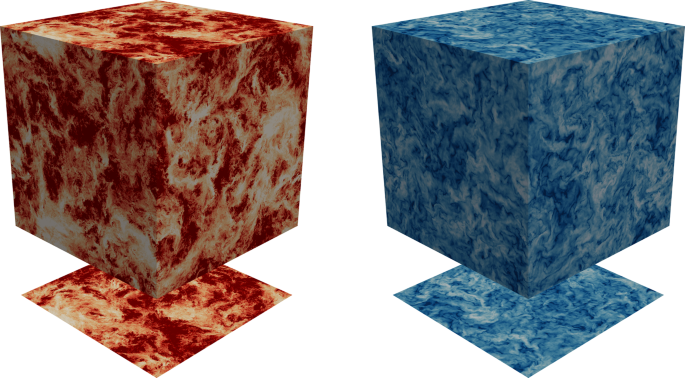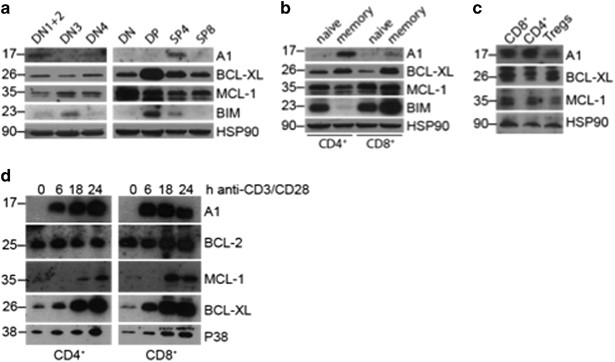
- Select a language for the TTS:
- UK English Female
- UK English Male
- US English Female
- US English Male
- Australian Female
- Australian Male
- Language selected: (auto detect) - EN
Play all audios:
ABSTRACT Magnetic fields on small scales are ubiquitous in the Universe. Although they can often be observed in detail, their generation mechanisms are not fully understood. One possibility
is the so-called small-scale dynamo (SSD). Prevailing numerical evidence, however, appears to indicate that an SSD is unlikely to exist at very low magnetic Prandtl numbers (PrM) such as
those that are present in the Sun and other cool stars. Here we have performed high-resolution simulations of isothermal forced turbulence using the lowest PrM values achieved so far.
Contrary to earlier findings, the SSD not only turns out to be possible for PrM down to 0.0031 but also becomes increasingly easier to excite for PrM below about 0.05. We relate this
behaviour to the known hydrodynamic phenomenon referred to as the bottleneck effect. Extrapolating our results to solar values of PrM indicates that an SSD would be possible under such
conditions. SIMILAR CONTENT BEING VIEWED BY OTHERS THE SPECTRUM OF MAGNETIZED TURBULENCE IN THE INTERSTELLAR MEDIUM Article 13 May 2025 THE SONIC SCALE OF INTERSTELLAR TURBULENCE Article 11
January 2021 MAGNETIC RECONNECTION IN THE ERA OF EXASCALE COMPUTING AND MULTISCALE EXPERIMENTS Article 07 February 2022 MAIN Astrophysical flows are considered to be susceptible to two types
of dynamo instability. First, a large-scale dynamo (LSD) is excited by flows exhibiting helicity, or more generally, lacking mirror symmetry, due to rotation, shear and/or stratification.
It generates coherent, dynamically relevant magnetic fields on the global scales of the object in question1. The characteristics of LSDs vary depending on the dominating generative effects,
such as differential rotation in the case of the Sun. Convective turbulence provides both generative and dissipative effects2, and their presence and astrophysical relevance is no longer
strongly debated. The presence of the other type of dynamo instability, namely the small-scale or fluctuation dynamo (SSD), however, remains controversial in solar and stellar physics. In an
SSD-active system, the magnetic field is generated at scales comparable to or smaller than the characteristic scales of the turbulent flow, enabled by chaotic stretching of field lines at
high magnetic Reynolds number3. In contrast to the LSD, excitation of an SSD requires markedly stronger turbulence1. Furthermore, it has been theorized that it becomes increasingly more
difficult to excite an SSD at very low magnetic Prandtl number PrM (refs. 4,5,6,7,8,9,10), the ratio of kinematic viscosity _ν_ and magnetic diffusivity _η_. In the Sun, PrM can reach values
as low as 10−6–10−4 (ref. 11), thus seriously repudiating whether an SSD can at all be present. Numerical models of SSDs in near-surface solar convection typically operate at PrM ≈ 1 (refs.
12,13,14,15,16,17,18) and thus circumvent the issue of low-PrM dynamos. A powerful SSD may potentially have a large impact on the dynamical processes in the Sun. It can, for example,
influence the angular momentum transport and therefore the generation of differential rotation19,20, interact with the LSD21,22,23,24,25 or contribute to coronal heating via enhanced
photospheric Poynting flux26. Hence, it is of great importance to clarify whether or not an SSD can exist in the Sun. Observationally, it is still debated whether the small-scale magnetic
field on the surface of the Sun has contributions from the SSD or is solely due to the tangling of the large-scale magnetic field by the turbulent motions27,28,29,30,31,32. However, these
studies show a slight preference of the small-scale fields to be cycle independent. SSDs at small PrM are also important for the interiors of planets and for liquid-metal experiments33.
Various numerical studies have reported increasing difficulties in exciting the SSD when decreasing PrM (refs. 6,10,34), confirming the theoretical predictions. However, current numerical
models reach only PrM = 0.03 using explicit physical diffusion or slightly lower (estimated) PrM, relying on artificial hyperdiffusion7,8. To achieve even lower PrM, one needs to increase
the grid resolution massively (see also ref. 35). Exciting the SSD requires a magnetic Reynolds number (ReM) typically larger than 100; hence, for example, PrM = 0.01 implies a fluid
Reynolds number Re = 104, where \({{{\rm{Re}}}}={u}_{{{{\rm{rms}}}}}\ell /\nu\), with _u_rms being the volume integrated root-mean-squared velocity, _ℓ_ a characteristic scale of the
velocity and ReM = PrMRe. In this Article, we take this path and lower PrM substantially using high-resolution simulations. RESULTS We include simulations with resolutions of 2563 to 4,6083
grid points and Re = 46 to Re = 33,000. This allows us to explore the parameter space from PrM = 1 to PrM = 0.0025, which is closer to the solar value than has been investigated in previous
studies. For each run, we measure the growth rate _λ_ of the magnetic field in its kinematic stage and determine whether or not an SSD is being excited. To afford an in-depth exploration of
the effect of PrM, we omit large-scale effects such as stratification, rotation and shear. We avoid the excessive integration times, required to simulate convection, by driving the turbulent
flow explicitly under isothermal conditions. Our simulation set-up consists of a fully periodic box with a random volume force (see Methods for details); the flow exhibits a Mach number of
around 0.08. In Fig. 1, we visualize the velocity and magnetic fields of one of the highest-resolution and -Reynolds-number cases. As might be anticipated for low-PrM turbulence, the flow
exhibits much finer, fractal-like structures than the magnetic field. Note that all our results refer to the kinematic stage of the SSD, where the magnetic field strength is far too weak to
influence the flow but otherwise arbitrary. GROWTH RATES AND CRITICAL MAGNETIC REYNOLDS NUMBERS In Fig. 2, we visualize the growth rate _λ_ as function of Re and ReM. We find positive growth
rates for all sets of runs with constant PrM if ReM is large enough. _λ_ increases always with increasing ReM as expected. Surprisingly, the growth rates are distinctly lower within the
interval from Re = 2,000 to Re = 10,000 than below and above. With the ReM values used, this maps roughly to a PrM interval from about 0.1 to 0.04. The growth rates for PrM = 0.1 match very
well the ones from ref. 10, indicated by triangles in Fig. 2. From Fig. 2, we clearly see that the critical magnetic Reynolds number \({{{{\rm{Re}}}}}_{{{{\rm{M}}}}}^{{{{\rm{crit}}}}}\),
defined by growth rate _λ_ = 0, first rises as a function of Re and then falls for Re > 3 × 103 (see the thin black line). Looking at \({{{{\rm{Re}}}}}_{{{{\rm{M}}}}}^{{{{\rm{crit}}}}}\)
as a function of magnetic Prandtl number PrM, it first increases with decreasing PrM and then decreases for PrM < 0.05. Hence, an SSD is easier to excite here than for 0.05 < PrM <
0.1. We could even find a nearly marginal, positive growth rate for PrM = 0.003125. The decrease of _λ_ at low PrM is an important result as the SSD was believed to be even harder4,9 or at
least equally hard7,8 to excite when PrM was decreased further from previously investigated values. The growth rates agree qualitatively with the earlier work at low PrM (refs. 6,7,8). For a
more accurate determination of \({{{{\rm{Re}}}}}_{{{{\rm{M}}}}}^{{{{\rm{crit}}}}}\), we next plot the growth rates for fixed PrM as a function of ReM (Fig. 3a). The data are consistent with
\(\lambda \propto \ln ({{{{\rm{Re}}}}}_{{{{\rm{M}}}}}/{{{{\rm{Re}}}}}_{{{{\rm{M}}}}}^{{{{\rm{crit}}}}})\) as theoretically predicted36,37. Fitting accordingly, we are able to determine
\({{{{\rm{Re}}}}}_{{{{\rm{M}}}}}^{{{{\rm{crit}}}}}\) as a function of PrM (Fig. 3b). This plot clearly shows that there are three distinct regions of dynamo excitation. When PrM decreases in
the range 1 ≥ PrM ≥ 0.1 it becomes much harder to excite the SSD. In the range 0.1 ≥ PrM ≥ 0.04, excitation is most difficult with little variation of
\({{{{\rm{Re}}}}}_{{{{\rm{M}}}}}^{{{{\rm{crit}}}}}\). For PrM ≤ 0.04, it again becomes easier as PrM reduces. In refs. 7,8, the authors already found an indication of
\({{{{\rm{Re}}}}}_{{{{\rm{M}}}}}^{{{{\rm{crit}}}}}\) to level-off with decreasing PrM, however, only when using artificial hyperdiffusion. Similarly, with our error bars, a constant
\({{{{\rm{Re}}}}}_{{{{\rm{M}}}}}^{{{{\rm{crit}}}}}\) cannot be excluded for 0.01 < PrM < 0.1. However, at PrM = 0.005, the error bar allows to conclude that
\({{{{\rm{Re}}}}}_{{{{\rm{M}}}}}^{{{{\rm{crit}}}}}\) is here lower than at PrM = 0.05. This again confirms our result that \({{{{\rm{Re}}}}}_{{{{\rm{M}}}}}^{{{{\rm{crit}}}}}\) is decreasing
with PrM for very low PrM. For PrM ≤ 0.05, the decrease of \({{{{\rm{Re}}}}}_{{{{\rm{M}}}}}^{{{{\rm{crit}}}}}\) with PrM can be well represented by the power law
\({{{{\rm{Re}}}}}_{{{{\rm{M}}}}}^{{{{\rm{crit}}}}}\propto {\Pr }_{{{{\rm{M}}}}}^{0.125}\). Extrapolating this to the Sun and solar-like stars would lead to
\({{{{\rm{Re}}}}}_{{{{\rm{M}}}}}^{{{{\rm{crit}}}}}\approx 40\) at PrM = 10−6, which means that we could expect an SSD to be present. For increasing Re, by decreasing _ν_, it would be
reasonable to assert that the statistical properties of the flow and hence \({{{{\rm{Re}}}}}_{{{{\rm{M}}}}}^{{{{\rm{crit}}}}}\) become independent of PrM. However, episodes of non-monotonic
behaviour of \({{{{\rm{Re}}}}}_{{{{\rm{M}}}}}^{{{{\rm{crit}}}}}\) when approaching this limit cannot be ruled out. The well-determined \({{{{\rm{Re}}}}}_{{{{\rm{M}}}}}^{{{{\rm{crit}}}}}\)
dependency on PrM together with its error bars and the power-law fit have been added to Fig. 2, and agree very well with the thin black line for _λ_ = 0 interpolated from the growth rates.
REGIONS OF DYNAMO EXCITATION Next we seek answers to the obvious question arising: why is the SSD harder to excite in a certain intermediate range of PrM and easier at lower and higher
values? For this, we investigate the kinetic and magnetic energy spectra of a representative subset of the runs (Supplementary Table 2). We show in Fig. 4 the spectra of two exemplary cases:
run F005, with PrM = 0.05, probes the PrM interval of impeded dynamo action, while run H0005, with PrM = 0.005, is clearly outside it (see Supplementary Figs. 1 and 2 for spectra of other
cases). In all cases, the kinetic energy as a function of wavenumber _k_ clearly follows a Kolmogorov cascade with _E_kin ∝ _k_−5/3 in the inertial range. When compensating with _k_5/3, we
find the well-known bottleneck effect38,39: a local increase in spectral energy, deviating from the power law, as found both in fluid experiments40,41,42 and numerical studies43,44. It has
been postulated to be detrimental to SSD growth4,10. For the magnetic spectrum, however, yet clearly visible for only PrM ≤ 0.005, we find a power law following _E_mag ∝ _k_−3. A 3/2 slope
at low wavenumbers as predicted by ref. 45 is seen only in the runs with PrM close to one, while for the intermediate and low-PrM runs, the positive-slope part of the spectrum shrinks to
cover only the lowest _k_ values, and the steep negative slopes at high _k_ values become prominent. A steep negative slope in the magnetic power spectra was also seen by ref. 7 for PrM
slightly below unity. However, the authors propose a tentative power of −1 given that the −3 slope is not yet clearly visible for their PrM values. Analysing our simulations, we adopt the
following strategy. For each spectrum, we determine the wavenumber of the bottleneck, _k_b, as the location of its maximum in the (smoothed) compensated spectrum, along with its starting
point _k_bs < _k_b at the location with 75% of the maximum (Fig. 4, middle). We additionally calculate a characteristic magnetic wavenumber, defined as _k_M =
∫_k__E_mag(_k_)_k_d_k_/∫_k__E_mag(_k_)d_k_, which is often connected with the energy-carrying scale. Furthermore, we calculate the viscous dissipation wavenumber \({k}_{\nu }={({\epsilon
}_{{{{\rm{K}}}}}/{\nu }^{3})}^{1/4}\) following Kolmogorov theory, where _ϵ_K is the viscous dissipation rate 2_ν__S_2 with the traceless rate-of-strain tensor of the flow, _S_. From the
relations between these four wavenumbers (listed in Supplementary Table 2), we draw insights about the observed behaviour of \({{{{\rm{Re}}}}}_{{{{\rm{M}}}}}^{{{{\rm{crit}}}}}\) with respect
to PrM. We plot _k_b/_k__ν_ and _k_bs/_k__ν_ as functions of PrM in Fig. 5. As is expected, _k_b/_k__ν_, or the ratio of the viscous scale to the scale of the bottleneck, does not depend on
PrM, as the bottleneck is a purely hydrodynamic phenomenon. The start of the bottleneck _k_bs should likewise not depend on PrM, but the low Re values for PrM = 1 to PrM = 0.1 lead to
apparent thinner bottlenecks, hence an unsystematic weak dependency. The red shaded area between _k_b and _k_bs is the low-wavenumber part of the bottleneck where the slope of the spectrum
is larger (less negative) than −5/3 (see Supplementary Table 2 for values of the modified slope _α_b and Supplementary Section 1 for a discussion). We note that _α_b ≈ −1.3 … −1.5 and can
thus deviate markedly from −5/3. Overplotting the _k_M/_k__ν_ curve reveals that it intersects with the red shaded area exactly where the dynamo is hardest to excite (region II). This lets
us conclude that the shallower slope of the low-wavenumber part of the bottleneck may indeed be responsible for enhancing \({{{{\rm{Re}}}}}_{{{{\rm{M}}}}}^{{{{\rm{crit}}}}}\) in the interval
0.04 ≤ PrM ≤ 0.1. Using this plot, we can now clearly explain the three regions of dynamo excitation. For 0.1 ≤ PrM ≤ 1 the low-wavenumber part of the bottleneck and the characteristic
magnetic scale are completely decoupled. This makes the SSD easy to excite (region I). For 0.04 ≤ PrM ≤ 0.1, (grey, region II), the dynamo is hardest to excite because of the shallower slope
of the kinetic spectra. In region III, where PrM ≤ 0.04 the low-wavenumber part of the bottleneck and the characteristic magnetic scale are again completely decoupled making the dynamo
easier to excite. Further, we find that the dependence of _k_M/_k__ν_ on PrM also differs between the regions. In region I, _k_M/_k__ν_ depends on PrM via \({k}_{{{{\rm{M}}}}}/{k}_{\nu
}\propto {\Pr }_{{{{\rm{M}}}}}^{0.54}\) and in region II and III via \({k}_{{{{\rm{M}}}}}/{k}_{\nu }\propto {\Pr }_{{{{\rm{M}}}}}^{0.71}\). This becomes particularly interesting when
comparing the characteristic magnetic wavenumber _k_M with the ohmic dissipation wavenumber which is defined as \({k}_{\eta }={k}_{\nu }{\Pr }_{{{{\rm{M}}}}}^{3/4}\). In region I, we find a
notable difference of _k_M and _k__η_ in value and scaling. However, in region III, the scaling of _k_M comes very close to the 3/4 scaling of _k__η_. This behaviour can be even better seen
in the inset of Fig. 5, where the ratio _k_M/_k__η_ is 0.3 for PrM = 1 and tends towards unity for decreasing PrM, but is likely to saturate below 0.75. DISCUSSION In conclusion, we find
that the SSD is progressively easier to excite for magnetic Prandtl numbers below 0.04, in contrast to earlier findings, and thus is very likely to exist in the Sun and other cool stars.
Provided saturation at sufficiently high levels, the SSD has been proposed to strongly influence the dynamics of solar-like stars: previous numerical studies, albeit at PrM ≈ 1, indicate
that this influence concerns, for example, the angular momentum transport19,20 and the LSD21,22,23,24,25. Our kinematic study, however, only shows that a positive growth rate is possible at
very low PrM, but not whether an SSD is able to generate dynamically important field strengths. As the ReM of the Sun and solar-like stars is several orders of magnitude higher than the
extrapolated \({{{{\rm{Re}}}}}_{{{{\rm{M}}}}}^{{{{\rm{crit}}}}}\) value of 40, we yet expect dynamically important SSDs as indicated by PrM = 1 simulations15. However, numerical simulations
with PrM down to 0.01 show a decrease of the saturation strength with decreasing PrM (ref. 46). The results of our study are well in agreement with previous numerical studies considering
partly overlapping PrM ranges6,7,8,10. Those studies found some discrepancies with the Kazantsev theory45 for low PrM, for example, the narrowing down of the positive Kazantsev spectrum at
low and intermediate wavenumbers, and the emergence of a negative slope instead at large wavenumbers7. We could extend this regime to even lower PrM and therefore study these discrepancies
further. For PrM ≤ 0.005, we find that the magnetic spectrum shows a power-law scaling _k_−3, which is substantially steeper than the tentative _k_−1 one proposed in ref. 7 for 0.03 ≲ PrM ≲
0.07 (but only for eighth-order hyperdiffusivity). This finding of such a steep power law in the magnetic spectrum challenges the current theoretical predictions and might indicate that the
SSD operating at low PrM is fundamentally different from that at PrM ≈ 1. Second, we find that the growth rates near the onset follow an ln(ReM) dependence as predicted by refs. 36,37, and
not a \({{{{\rm{Re}}}}}_{{{{\rm{M}}}}}^{1/2}\) one as would result from intertial-range-driven SSDs1,7. We do not observe a tendency of the growth rate to become independent of ReM at the
highest PrM either, which could be an indication of an outer-scale driven SSD, as postulated by ref. 7. Furthermore, we find that the pre-factor of \(\gamma \propto \ln
({{{{\rm{Re}}}}}_{{{{\rm{M}}}}}/{{{{\rm{Re}}}}}_{{{{\rm{M}}}}}^{{{{\rm{crit}}}}})\) is nearly constant with its mean around 0.022, in agreement with 0.023 of ref. 10. A constant value means
that the logarithmic scaling is independent of PrM and seems to be of general validity. Third, we find that the measured characteristic magnetic wavenumber _k_M is always smaller than the
estimated _k__η_, and furthermore, _k_M does not always follow the theory-predicted scaling of \({k}_{\eta }\propto {\Pr }_{{{{\rm{M}}}}}^{3/4}\) with PrM. For region I, where PrM is close
to 1, this discrepancy is up to a factor of three and the deviation from the expected PrM scaling is most pronounced here. These discrepancies have been associated with the numerical set-ups
injecting energy at a forcing scale far larger than the dissipation scale, that is _k_f ≪ _k__η_ (ref. 1). Furthermore, our runs in region I also have relatively low Re and therefore
numerical effects are not dismissible. In region III (low PrM), _k_M/_k__η_ is approaching the constant offset factor 0.75. Hence, the scaling of _k_M/_k__η_ with PrM gets close to the
expected one. This result again indicates that the SSD at low PrM is different from that at PrM ≈ 1. An increase of \({{{{\rm{Re}}}}}_{{{{\rm{M}}}}}^{{{{\rm{crit}}}}}\) with decreasing PrM
followed by an asymptotic levelling-off for PrM ≪ 1 was expected in the light of theory and previous numerical studies. Instead, we found non-monotonic behaviour as function of PrM; we could
relate it to the hydrodynamical phenomenon of the bottleneck. If the characteristic magnetic wavenumber lies in the positive-gradient part of the compensated spectrum, where the spectral
slope is markedly reduced from −5/3 to about −1.4, the dynamo is hardest to excite (0.1 ≥ PrM ≥ 0.04). For higher or lower PrM, the dynamo becomes increasingly easier to excite. The local
change in slope due to the bottleneck has often been related to an increase of the ‘roughness’ of the flow1,10,43, which is expected to harden dynamo excitation based on theoretical
predictions4,9 from kinematic Kazantsev theory45. In line with theory, the roughness-increasing part of the bottleneck appears decisive in our results, however, only when _k_M is used as a
criterion. The usage of _k__η_ would in contrast suggest that the peak of the bottleneck is decisive10. Such interpretation appears incorrect, as the rough estimate of _k__η_ employed here
does not represent the magnetic spectrum adequately and the peak of the bottleneck does not coincide with the maximum of ‘roughness’. METHODS NUMERICAL SET-UP For our simulations, we use a
cubic Cartesian box with edge length _L_ and solve the isothermal magnetohydrodynamic equations without gravity, similar to refs. 5,47.
$$\frac{{{{\rm{D}}}}{{{\bf{u}}}}}{{{{\rm{D}}}}t}=-{c}_{{{{\rm{s}}}}}^{2}{\nabla}\ln \rho +{{{\bf{J}}}}\times {{{\bf{B}}}}/\rho +{\nabla}\cdot (2\rho \nu {\mathsf{S}})/\rho +{{{\bf{f}}}},$$
(1) $$\frac{\partial {{{\bf{A}}}}}{\partial t}={{{\bf{u}}}}\times {{{\bf{B}}}}+\eta {\nabla}^{2}{{{\bf{A}}}},$$ (2) $$\frac{{{{\rm{D}}}}\rho }{{{{\rm{D}}}}t}=-{\nabla}\cdot (\rho
{{{\bf{u}}}}),$$ (3) where U is the flow speed, _c_s is the sound speed, _ρ_ is the mass density, B = ∇ × A is the magnetic field with A being the vector potential and ∇ is the gradient
vector. J = ∇ × B/_μ_0 is the current density with magnetic vacuum permeability _μ_0, while _ν_ and _η_ are constant kinematic viscosity and magnetic diffusivity, respectively. The
rate-of-strain tensor _S__i__j_ = (_u__i_,_j_ + _u__j_,_i_)/2 − _δ__i__j_∇ ⋅ U/3 is traceless, where _δ__ij_ denotes the Kronecker delta, and the Einstein notation convection applying to
their indices _i_ and _j_. The forcing function F provides random white-in-time non-helical transversal plane waves, which are added in each time step to the momentum equation (see ref. 5
for details). The wavenumbers of the forcing lie in a narrow band around _k_f = 2_k_1 with _k_1 = 2π/_L_. Its amplitude is chosen such that the Mach number Ma = _u_rms/_c_s is always around
0.082, where \({u}_{{{{\rm{rms}}}}}=\sqrt{{\langle {{{{\bf{u}}}}}^{2}\rangle }_{V}}\) is the volume and time-averaged root-mean-square value. The Ma values of all runs are listed in
Supplementary Table 1. To normalize the growth rate _λ_, we use an estimated turnover time _τ_ = 1/(_u_rms_k_f )≈ 6/(_k_1_c_s). The boundary conditions are periodic for all quantities and we
initialize the magnetic field with weak Gaussian noise. Diffusion is controlled by the prescribed parameters _ν_ and _η_. Accordingly, we define the fluid and magnetic Reynolds numbers with
the forcing wavenumber _k_f as $${{{\rm{Re}}}}={u}_{{{{\rm{rms}}}}}/\nu {k}_{{{{\rm{f}}}}},\quad {{{{\rm{Re}}}}}_{{{{\rm{M}}}}}={u}_{{{{\rm{rms}}}}}/\eta {k}_{{{{\rm{f}}}}}.$$ (4) We
performed numerical free decay experiments (Supplementary Section 7), from which we confirm that the numerical diffusivities are negligible. The spectral kinetic and magnetic energy
densities are defined via $${\int}_{k}{E}_{{{{\rm{kin}}}}}(k)\,{\mathrm{d}}k={u}_{{{{\rm{rms}}}}}^{2}\,{\langle \rho \rangle }_{V}/2,$$ (5)
$${\int}_{k}{E}_{{{{\rm{mag}}}}}(k)\,{\mathrm{d}}k={B}_{{{{\rm{rms}}}}}^{2}/2{\mu }_{0},$$ (6) where \({B}_{{{{\rm{rms}}}}}=\sqrt{{\langle {{{{\boldsymbol{B}}}}}^{2}\rangle }_{V}}\) is the
volume-averaged root-mean-square value and 〈_ρ_〉_V_ is the volume-averaged density. Our numerical set-up employs a markedly simplified model of turbulence compared with the actual one in the
Sun. There, turbulence is driven by stratified rotating convection being of course neither isothermal nor isotropic. However, these simplifications were so far necessary when performing a
parameter study at such high resolutions as we do. Nevertheless, we can connect our study to solar parameters in terms of PrM and Ma. Their chosen values best represent the weakly stratified
layers within the bulk of the solar convection zone, where PrM ≪ 1 and Ma ≪ 1. The anisotropy in the flow on small scales is much weaker there than near the surface and therefore close to
our simplified set-up. DATA AVAILABILITY Data for reproducing Figs. 2, 3 and 5 are included in the article and its Supplementary Information files. The raw data (time series, spectra, slices
and snapshots) are provided through IDA/Fairdata service hosted at CSC, Finland, under https://doi.org/10.23729/206af669-07fd-4a30-9968-b4ded5003014. From the raw data, Figs. 1 and 4 can be
reproduced. CODE AVAILABILITY We use the Pencil Code48 to perform all simulations, with parallelized fast-Fourier-transforms to calculate the spectra on the fly49. Pencil Code is freely
available at https://github.com/pencil-code/. REFERENCES * Brandenburg, A. & Subramanian, K. Astrophysical magnetic fields and nonlinear dynamo theory. _Phys. Rep._ 417, 1–209 (2005).
Article ADS MathSciNet Google Scholar * Charbonneau, P. Dynamo models of the solar cycle. _Living Rev. Sol. Phys._ 17, 4 (2020). Article ADS Google Scholar * Childress, S. &
Gilbert, A. D. _Stretch, Twist, Fold: The Fast Dynamo_ Lecture Notes in Physics Monographs Vol. 37 (Springer, 1995). * Boldyrev, S. & Cattaneo, F. Magnetic-field generation in Kolmogorov
turbulence. _Phys. Rev. Lett._ 92, 144501 (2004). Article ADS Google Scholar * Haugen, N. E. L. & Brandenburg, A. Suppression of small scale dynamo action by an imposed magnetic
field. _Phys. Rev. E_ 70, 036408 (2004). Article ADS Google Scholar * Schekochihin, A. A., Cowley, S. C., Maron, J. L. & McWilliams, J. C. Critical magnetic Prandtl number for
small-scale dynamo. _Phys. Rev. Lett._ 92, 054502 (2004). Article ADS Google Scholar * Schekochihin, A. A. et al. Fluctuation dynamo and turbulent induction at low magnetic Prandtl
numbers. _New J. Phys._ 9, 300 (2007). Article ADS Google Scholar * Iskakov, A. B., Schekochihin, A. A., Cowley, S. C., McWilliams, J. C. & Proctor, M. R. E. Numerical demonstration
of fluctuation dynamo at low magnetic Prandtl numbers. _Phys. Rev. Lett._ 98, 208501 (2007). Article ADS Google Scholar * Schober, J., Schleicher, D., Bovino, S. & Klessen, R. S.
Small-scale dynamo at low magnetic Prandtl numbers. _Phys. Rev. E_ 86, 066412 (2012). Article ADS Google Scholar * Brandenburg, A., Haugen, N. E. L., Li, X.-Y. & Subramanian, K.
Varying the forcing scale in low Prandtl number dynamos. _Mon. Not. R. Astron. Soc._ 479, 2827–2833 (2018). Article ADS Google Scholar * Stix, M. _The Sun: An Introduction_ (Springer,
2002). * Cattaneo, F. On the origin of magnetic fields in the quiet photosphere. _Astrophys. J._ 515, 39–42 (1999). Article ADS Google Scholar * Vögler, A. & Schüssler, M. A solar
surface dynamo. _Astron. Astrophys._ 465, L43–L46 (2007). Article ADS Google Scholar * Kitiashvili, I. N., Kosovichev, A. G., Mansour, N. N. & Wray, A. A. Realistic modeling of local
dynamo processes on the Sun. _Astrophys. J._ 809, 84 (2015). Article ADS Google Scholar * Hotta, H., Rempel, M. & Yokoyama, T. Efficient small-scale dynamo in the solar convection
zone. _Astrophys. J._ 803, 42 (2015). Article ADS Google Scholar * Rempel, M. Numerical simulations of quiet Sun magnetism: on the contribution from a small-scale dynamo. _Astrophys. J._
789, 132 (2014). Article ADS Google Scholar * Rempel, M. Small-scale dynamo simulations: magnetic field amplification in exploding granules and the role of deep and shallow recirculation.
_Astrophys. J._ 859, 161 (2018). Article ADS Google Scholar * Riva, F. & Steiner, O. Methodology for estimating the magnetic Prandtl number and application to solar surface
small-scale dynamo simulations. _Astron. Astrophys._ 660, A115 (2022). Article ADS Google Scholar * Käpylä, P. J., Käpylä, M. J., Olspert, N., Warnecke, J. & Brandenburg, A.
Convection-driven spherical shell dynamos at varying Prandtl numbers. _Astron. Astrophys._ 599, A4 (2017). * Hotta, H. & Kusano, K. Solar differential rotation reproduced with
high-resolution simulation. _Nat. Astron._ 5, 1100–1102 (2021). Article ADS Google Scholar * Tobias, S. M. & Cattaneo, F. Shear-driven dynamo waves at high magnetic Reynolds number.
_Nature_ 497, 463–465 (2013). Article ADS Google Scholar * Bhat, P., Subramanian, K. & Brandenburg, A. A unified large/small-scale dynamo in helical turbulence. _Mon. Not. R. Astron.
Soc._ 461, 240–247 (2016). Article ADS Google Scholar * Squire, J. & Bhattacharjee, A. The magnetic shear-current effect: generation of large-scale magnetic fields by the small-scale
dynamo. _J. Plasma Phys._ 82, 535820201 (2016). Article Google Scholar * Hotta, H., Rempel, M. & Yokoyama, T. Large-scale magnetic fields at high Reynolds numbers in
magnetohydrodynamic simulations. _Science_ 351, 1427–1430 (2016). Article ADS MathSciNet MATH Google Scholar * Väisälä, M. S. et al. Interaction of large- and small-scale dynamos in
isotropic turbulent flows from GPU-accelerated simulations. _Astrophys. J._ 907, 83 (2021). Article ADS Google Scholar * Rempel, M. Extension of the MURaM radiative MHD code for coronal
simulations. _Astrophys. J._ 834, 10 (2017). Article ADS Google Scholar * Kleint, L., Berdyugina, S. V., Shapiro, A. I. & Bianda, M. Solar turbulent magnetic fields: surprisingly
homogeneous distribution during the solar minimum. _Astron. Astrophys._ 524, A37 (2010). * Buehler, D., Lagg, A. & Solanki, S. K. Quiet Sun magnetic fields observed by Hinode: support
for a local dynamo. _Astron. Astrophys._ 555, A33 (2013). * Lites, B. W., Centeno, R. & McIntosh, S. W. The solar cycle dependence of the weak internetwork flux. _Publ. Astron. Soc. Jpn_
66, S4 (2014). * Bellot Rubio, L. & Orozco Suárez, D. Quiet Sun magnetic fields: an observational view. _Living Rev. Sol. Phys._ 16, 1 (2019). Article ADS Google Scholar * Faurobert,
M. & Ricort, G. Magnetic flux structuring of the quiet Sun internetwork. Center-to-limb analysis of solar-cycle variations. _Astron. Astrophys._ 651, A21 (2021). * Korpi-Lagg, M. J.,
Korpi-Lagg, A., Olspert, N. & Truong, H.-L. Solar-cycle variation of quiet-sun magnetism and surface gravity oscillation mode. _Astron. Astrophys._ 665, A141 (2022). Article ADS Google
Scholar * Tobias, S. M. The turbulent dynamo. _J. Fluid Mech._ 912, 1 (2021). Article ADS MathSciNet MATH Google Scholar * Schekochihin, A. A. et al. The onset of a small-scale
turbulent dynamo at low magnetic Prandtl numbers. _Astrophys. J._ 625, 115–118 (2005). Article Google Scholar * Tobias, S. M., Cattaneo, F. & Boldyrev, S. in _Ten Chapters in
Turbulence_ (eds Davidson, P. A. et al.) 351–404 (Cambridge Univ. Press, 2012); https://doi.org/10.1017/CBO9781139032810.010 * Rogachevskii, I. & Kleeorin, N. Intermittency and anomalous
scaling for magnetic fluctuations. _Phys. Rev. E_ 56, 417–426 (1997). Article ADS Google Scholar * Kleeorin, N. & Rogachevskii, I. Growth rate of small-scale dynamo at low magnetic
Prandtl numbers. _Phys. Scr._ 86, 018404 (2012). Article ADS MATH Google Scholar * Falkovich, G. Bottleneck phenomenon in developed turbulence. _Phys. Fluids_ 6, 1411–1414 (1994).
Article ADS MATH Google Scholar * Lohse, D. & Müller-Groeling, A. Bottleneck effects in turbulence: scaling phenomena in _r_ versus _p_ space. _Phys. Rev. Lett._ 74, 1747–1750
(1995). Article ADS Google Scholar * She, Z.-S. & Jackson, E. On the universal form of energy spectra in fully developed turbulence. _Phys. Fluids A_ 5, 1526–1528 (1993). Article ADS
Google Scholar * Saddoughi, S. G. & Veeravalli, S. V. Local isotropy in turbulent boundary layers at high Reynolds number. _J. Fluid Mech._ 268, 333–372 (1994). Article ADS Google
Scholar * Küchler, C., Bewley, G. & Bodenschatz, E. Experimental study of the bottleneck in fully developed turbulence. _J. Stat. Phys._ 175, 617–639 (2019). Article ADS MATH Google
Scholar * Dobler, W., Haugen, N. E., Yousef, T. A. & Brandenburg, A. Bottleneck effect in three-dimensional turbulence simulations. _Phys. Rev. E_ 68, 026304 (2003). Article ADS
Google Scholar * Donzis, D. A. & Sreenivasan, K. R. The bottleneck effect and the Kolmogorov constant in isotropic turbulence. _J. Fluid Mech._ 657, 171–188 (2010). Article ADS MATH
Google Scholar * Kazantsev, A. P. Enhancement of a magnetic field by a conducting fluid. _Sov. J. Exp. Theor. Phys._ 26, 1031 (1968). ADS Google Scholar * Brandenburg, A. Nonlinear
small-scale dynamos at low magnetic Prandtl numbers. _Astrophys. J._ 741, 92 (2011). Article ADS Google Scholar * Brandenburg, A. The inverse cascade and nonlinear alpha-effect in
simulations of isotropic helical hydromagnetic turbulence. _Astrophys. J._ 550, 824–840 (2001). Article ADS Google Scholar * Pencil Code Collaboration et al. The Pencil Code, a modular
MPI code for partial differential equations and particles: multipurpose and multiuser-maintained. _J. Open Source Softw._ 6, 2807 (2021). Article ADS Google Scholar * Bourdin, P.-A.
Driving solar coronal MHD simulations on high-performance computers. _Geophys. Astrophys. Fluid Dyn._ 114, 235–260 (2020). Article ADS MathSciNet MATH Google Scholar Download references
ACKNOWLEDGEMENTS We acknowledge fruitful discussions with A. Brandenburg, I. Rogachevskii, A. Schekochihin and J. Schober during the Nordita programme on ‘Magnetic field evolution in low
density or strongly stratified plasmas’. Computing resources from CSC during the Mahti pilot project and from Max Planck Computing and Data Facility (MPCDF) are gratefully acknowledged. This
project, including all authors, has received funding from the European Research Council (ERC) under the European Union’s Horizon 2020 research and innovation programme (Project UniSDyn,
grant agreement number 818665). This work was done in collaboration with the COFFIES DRIVE Science Center. FUNDING Open access funding provided by Max Planck Society AUTHOR INFORMATION
AUTHORS AND AFFILIATIONS * Max-Planck-Institut für Sonnensystemforschung, Göttingen, Germany Jörn Warnecke & Maarit J. Korpi-Lagg * Department of Computer Science, Aalto University,
Espoo, Finland Maarit J. Korpi-Lagg, Frederick A. Gent & Matthias Rheinhardt * Nordita, KTH Royal Institute of Technology and Stockholm University, Stockholm, Sweden Maarit J. Korpi-Lagg
* School of Mathematics, Statistics and Physics, Newcastle University, Newcastle upon Tyne, UK Frederick A. Gent Authors * Jörn Warnecke View author publications You can also search for
this author inPubMed Google Scholar * Maarit J. Korpi-Lagg View author publications You can also search for this author inPubMed Google Scholar * Frederick A. Gent View author publications
You can also search for this author inPubMed Google Scholar * Matthias Rheinhardt View author publications You can also search for this author inPubMed Google Scholar CONTRIBUTIONS J.W. led
and all the authors contributed to the design and performing the numerical simulations. J.W. led the data analysis. M.J.K.-L. was in charge of acquiring the computational resources from CSC.
All the authors contributed to the interpretation of the results and writing the paper. CORRESPONDING AUTHOR Correspondence to Jörn Warnecke. ETHICS DECLARATIONS COMPETING INTERESTS The
authors declare no competing interests. PEER REVIEW PEER REVIEW INFORMATION _Nature Astronomy_ thanks Hideyuki Hotta, Michael Rieder and the other, anonymous, reviewer(s) for their
contribution to the peer review of this work. ADDITIONAL INFORMATION PUBLISHER’S NOTE Springer Nature remains neutral with regard to jurisdictional claims in published maps and institutional
affiliations. SUPPLEMENTARY INFORMATION SUPPLEMENTARY INFORMATION Supplementary Figs. 1–5, Tables 1–3, and discussions in Supplementary Sections 1–6 with references. RIGHTS AND PERMISSIONS
OPEN ACCESS This article is licensed under a Creative Commons Attribution 4.0 International License, which permits use, sharing, adaptation, distribution and reproduction in any medium or
format, as long as you give appropriate credit to the original author(s) and the source, provide a link to the Creative Commons license, and indicate if changes were made. The images or
other third party material in this article are included in the article’s Creative Commons license, unless indicated otherwise in a credit line to the material. If material is not included in
the article’s Creative Commons license and your intended use is not permitted by statutory regulation or exceeds the permitted use, you will need to obtain permission directly from the
copyright holder. To view a copy of this license, visit http://creativecommons.org/licenses/by/4.0/. Reprints and permissions ABOUT THIS ARTICLE CITE THIS ARTICLE Warnecke, J., Korpi-Lagg,
M.J., Gent, F.A. _et al._ Numerical evidence for a small-scale dynamo approaching solar magnetic Prandtl numbers. _Nat Astron_ 7, 662–668 (2023). https://doi.org/10.1038/s41550-023-01975-1
Download citation * Received: 02 July 2022 * Accepted: 14 April 2023 * Published: 18 May 2023 * Issue Date: June 2023 * DOI: https://doi.org/10.1038/s41550-023-01975-1 SHARE THIS ARTICLE
Anyone you share the following link with will be able to read this content: Get shareable link Sorry, a shareable link is not currently available for this article. Copy to clipboard Provided
by the Springer Nature SharedIt content-sharing initiative








